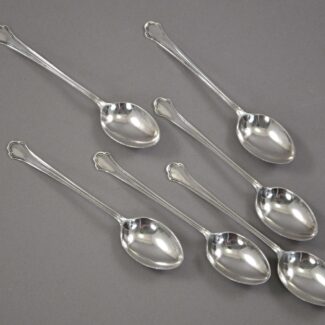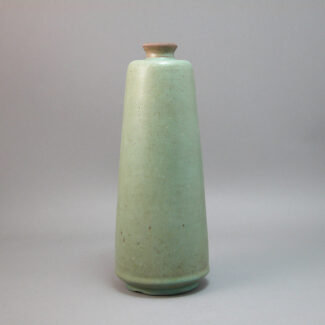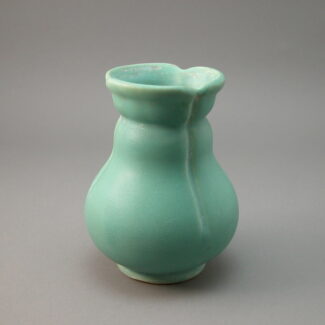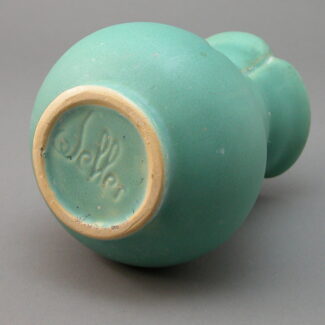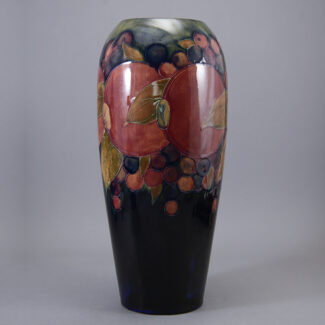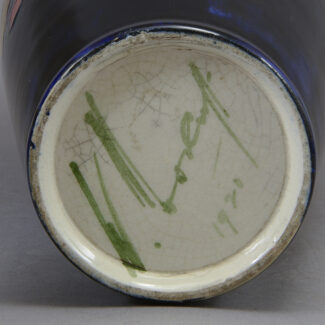Royal Doulton (England, Est. 1815)
Sir Frank William Brangwyn (Belgian/British, 1867-1956) RA, RSW, SGA, RBSA
Brangwyn Ware ‘Floral’ Vase, Pattern D5162, c. 1932
glazed, hand-painted, pottery
6 ¼” high x 4 ½” diameter x 7 ¼” wide (at handles)
Description: A fine earthenware vase with a decidedly art deco cylindrical form with distinctive disc mouth and flanked by prominent fin handles, all decorated with a sgraffito tangled garden décor coloured with hand-painted underglaze pastels in a progressive and modern British sensibility.
Markings: Royal Doulton backstamp for 1932; inscribed Pattern Number D5162; signed artists signature; impressed Form No ‘8002’
Condition: Antique, Excellent
Designer Biography: Sir Frank William Brangwyn RA RWS RBA (12 May 1867 – 11 June 1956) was a Welsh artist, painter, watercolourist, printmaker, illustrator, and designer.
Brangwyn worked in a wide range of artistic fields. As well as paintings and drawings, he produced designs for stained glass, furniture, ceramics, glass tableware, mosaics, buildings and interiors, was a lithographer and woodcutter and was a book illustrator. It has been estimated that during his lifetime Brangwyn produced over 12,000 works. His mural commissions would cover over 22,000 sq ft (2,000 m2) of canvas, he painted over 1,000 oils, over 660 mixed media works (watercolours, gouache), over 500 etchings, about 400 wood-engravings and woodcuts, 280 lithographs, 40 architectural and interior designs, 230 designs for items of furniture and 20 stained glass panels and windows.
Brangwyn received some artistic training, probably from his father, and later from Arthur Heygate Mackmurdo and in the workshops of William Morris, but he was largely an autodidact without a formal artistic education. When, at the age of 17, one of his paintings was accepted at the Royal Academy Summer Exhibition, he was strengthened in his conviction to become an artist. Initially, he painted traditional subjects about the sea and life on the seas. His 1890 canvas, Funeral At Sea won a medal of the third class at the 1891 Paris Salon.[1] The murals for which Brangwyn was famous, and during his lifetime he was very famous indeed, were brightly coloured and crowded with details of plants and animals, although they became flatter and less flamboyant later in his life
AWARDS & HONOURS: Medal, Paris Salon (1891); Medal (x2), Chicago Exhibition (1894); Gold Medal, Munich (1897); Silver Medal, Great Exhibition Paris (1897); Chevalier of the Legion of Honour (1902); Associate member of the Royal Academy (1904); Gold Medal, Venice & Grand Prix of Milon (1906); Commemorative Diploma, Japan-British Exhibition (1910); Chevalier of the Order of the Crown of Italy (1911); Gold Medal, Berlin Salin (1912); Commander of the Italian Order of Saints Maurice and Lazarus (1917); Commander and Cross of the Order of Leopold I of Belgium (1919); First President, Society of Graphic Art (1919); Full Member, Royal Academy (1919); President, Royal Birmingham Society of Artists (1925-1926); The Albert Medal (1932); Grand Officer of the Order of Leopold II of Belgium (1936); Knight Bachelor, Great Britain (1941)

